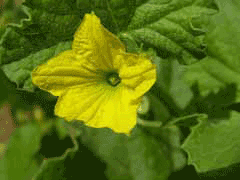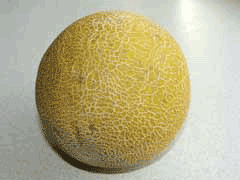 |
|
http://www.flickr.com/photos/valter/ |
 |
| http://commons.wikimedia.org/wiki/User:Pkuczynski |
Translate this page:
Summary
Physical Characteristics

 Cucumis melo is a ANNUAL CLIMBER growing to 1.5 m (5ft).
Cucumis melo is a ANNUAL CLIMBER growing to 1.5 m (5ft).
See above for USDA hardiness. It is hardy to UK zone 10 and is frost tender. It is in flower from July to September, and the seeds ripen from August to October. The species is monoecious (individual flowers are either male or female, but both sexes can be found on the same plant) and is pollinated by Insects. The plant is self-fertile.
Suitable for: light (sandy), medium (loamy) and heavy (clay) soils and prefers well-drained soil. Suitable pH: mildly acid, neutral and basic (mildly alkaline) soils. It cannot grow in the shade. It prefers moist soil.
UK Hardiness Map
US Hardiness Map
Synonyms
Plant Habitats
Cultivated Beds;
Edible Uses
Edible Parts: Fruit Oil Seed
Edible Uses: Oil
Fruit - raw[1, 2, 46, 105]. Very watery but with a delicate flavour, it is very refreshing. Rich in vitamins B and C[201]. The flesh of the fruit can be dried, ground into a powder and used with cereals when making bread, biscuits etc[257]. The size of the fruit varies widely between cultivars but is up to 10cm long and 7cm wide[200]. Seed - raw[57, 86, 105]. Rich in oil with a nutty flavour but very fiddly to use because the seed is small and covered with a fibrous coat[K]. The seed contains between 12.5 - 39.1% oil[218]. An edible oil is obtained from the seed[105, 183].
References More on Edible Uses
Medicinal Uses
Plants For A Future can not take any responsibility for any adverse effects from the use of plants. Always seek advice from a professional before using a plant medicinally.
Antitussive Digestive Diuretic Emetic Expectorant Febrifuge Stomachic Vermifuge
The fruits can be used as a cooling light cleanser or moisturiser for the skin[201]. They are also used as a first aid treatment for burns and abrasions[201]. The flowers are expectorant and emetic[218]. The fruit is stomachic[218]. The seed is antitussive, digestive, febrifuge and vermifuge[218]. When used as a vermifuge, the whole seed complete with the seed coat is ground into a fine flour, then made into an emulsion with water and eaten. It is then necessary to take a purge in order to expel the tapeworms or other parasites from the body[7]. The root is diuretic and emetic[218].
References More on Medicinal Uses
The Bookshop: Edible Plant Books
Our Latest books on Perennial Plants For Food Forests and Permaculture Gardens in paperback or digital formats.

Edible Tropical Plants
Food Forest Plants for Hotter Conditions: 250+ Plants For Tropical Food Forests & Permaculture Gardens.
More

Edible Temperate Plants
Plants for Your Food Forest: 500 Plants for Temperate Food Forests & Permaculture Gardens.
More

More Books
PFAF have eight books available in paperback and digital formats. Browse the shop for more information.
Shop Now
Other Uses
Oil
None known
Special Uses
References More on Other Uses
Cultivation details
Requires a rich, well-drained moisture retentive soil and a warm, very sunny position[200]. A frost-tender annual plant, the melon is widely cultivated in gardens and commercially, especially in warmer climates than Britain, for its edible fruit. Some varieties may succeed outdoors in Britain in hot summers but in general it is best to grow melons under protection in this country[1, 200]. This is a very variable species that has long been cultivated for its edible fruit. As a result, a number of distinct forms have arisen and there are many named varieties within each of these forms[1, 46, 183]. These forms have been classified by botanists into groups as detailed below. Each of these groups has been given a separate entry in the database. C. melo agrestis. A wild form of the melon. It is not usually grown for its fruit but is of potential value in breeding programmes. C. melo cantalupensis. The cantaloupe or netted melons. C. melo chito. The orange melon. This form occasionally escapes from cultivation and is naturalized in some tropical and sub-tropical areas. C. melo conomon. The pickling or sweet melon. This form is also of value in breeding programmes for disease resistance. C. melo flexuosus. The serpent melon. C. melo inodorus. The honeydew melon. C. melo momordica. The snap melon. This form is also of value in breeding programmes for pest and disease resistance. Grows well with corn and sunflowers but dislikes potatoes[20, 201]. The weeds fat hen and sow thistle improve the growth and cropping of melons[201].
References Carbon Farming Information and Carbon Sequestration Information
Temperature Converter
Type a value in the Celsius field to convert the value to Fahrenheit:
Fahrenheit:
The PFAF Bookshop
Plants For A Future have a number of books available in paperback and digital form. Book titles include Edible Plants, Edible Perennials, Edible Trees,Edible Shrubs, Woodland Gardening, and Temperate Food Forest Plants. Our new book is Food Forest Plants For Hotter Conditions (Tropical and Sub-Tropical).
Shop Now
Plant Propagation
Seed - sow early to mid spring in a greenhouse in a rich soil. Germination should take place within 2 weeks. Sow 2 or 3 seeds per pot and thin out to the best plant. Grow them on fast and plant out after the last expected frosts, giving them cloche or frame protection for at least their first few weeks if you are trying them outdoors.
Other Names
If available other names are mentioned here
Armenian cucumber,
Dudaim melon,
Cantalope,
Queen Anne's melon,
Muskmelon,
Snake cucumber, Akobokobo, Akolil, Atimon, Blewah, Bluwak, Budamakaya, Chiratu, Chukkangai, Itimon, Kaachri, Kachri, Karitu, Kayimbe, Kharbuja, Kharbujadosa, Kharmuj, Kothimdu, Luwinbe, Madhupaka, Milon, Mpombe, Mulampazham, Musk-melon, Putzakova, Sane, Semangka londo, Syrian cucumber, Taena-thai, Teeng laay, Thumattikai, Trasak srow.
Native Range
TEMPERATE ASIA: China, Iran, Japan, Korea, Saudi Arabia, Yemen,Oman. TROPICAL ASIA: India, Sri Lanka, Maldives, Nepal, Pakistan, Papua New Guinea, Solomon Islands, Myanmar, Thailand, Indonesia, Philippines, PACIFIC: United States, Guam, Tonga, Samoa AUSTRALASIA: Australia AFRICA: Eritrea, Ethiopia, Sudan, Somalia, Chad, Tanzania, Uganda, Benin, Côte D Ivoire, Ghana, Niger, Senegal, Mozambique, Malawi, Zimbabwe, South Africa, Seychelles.
Weed Potential
Right plant wrong place. We are currently updating this section.
Please note that a plant may be invasive in one area but may not in your area so it's worth checking.
Invasive in Arizona and California and potentially other locations with similar climates.
Conservation Status
IUCN Red List of Threatened Plants Status : This taxon has not yet been assessed.

Growth: S = slow M = medium F = fast. Soil: L = light (sandy) M = medium H = heavy (clay). pH: A = acid N = neutral B = basic (alkaline). Shade: F = full shade S = semi-shade N = no shade. Moisture: D = dry M = Moist We = wet Wa = water.
Now available:
Food Forest Plants for Mediterranean Conditions
350+ Perennial Plants For Mediterranean and Drier Food Forests and Permaculture Gardens.
[Paperback and eBook]
This is the third in Plants For A Future's series of plant guides for food forests tailored to
specific climate zones. Following volumes on temperate and tropical ecosystems, this book focuses
on species suited to Mediterranean conditions—regions with hot, dry summers and cool, wet winters,
often facing the added challenge of climate change.
Read More
Expert comment
Author
L.
Botanical References
200
Links / References
For a list of references used on this page please go here
Readers comment
| Add a comment |
|
If you have important information about this plant that may help other users please add a comment or link below. Only comments or links that are felt to be directly relevant to a plant will be included. If you think a comment/link or information contained on this page is inaccurate or misleading we would welcome your feedback at [email protected]. If you have questions about a plant please use the Forum on this website as we do not have the resources to answer questions ourselves.
* Please note: the comments by website users are not necessarily those held by PFAF and may give misleading or inaccurate information.
To leave a comment please Register or login here All comments need to be approved so will not appear immediately.
|
|